Zoanthids
Predators
Asterina Starfish!!
Not all Asterina Starfish are Zoanthid predators. In fact, as a whole, Asterinas are generally considered Reef Safe. However, the Asterina family is HUGE and there are types that do eat/kill Zoanthids!
Nudibranch or Nudis!!
One of the most difficult pests to fully eradicate in most reef systems are the Zoanthid eating nudibranch. With their uncanny ability to hitchhike into the tank in nearly any coral colony, and to spread into plague proportions at record speed, they have fully established their reputation as a pest that cannot be taken lightly. Over the years, several methods for treating these pests have emerged, from freshwater iodine dips to manual removal, but all of these methods seemed to extremely stress the zoanthid colonies as well. Zoanthids were being lost during dips, they became much more susceptible to fungus, and a new method had yet to emerge.
I had initially set out to remove another pest: a large mass of flatworms that were on a colony of zoanthids. The red flatworms had reproduced to the point that they were completely drowning out the zoanthids, and the colony had been closed for nearly a week. I placed 8 drops of Salifert's Flatworm Exit (FWE), an excellent flatworm treatment medication, into 3 gallons of tank water in a bucket.
After 10 minutes, I removed the zoanthids colony, and noted that all of the flatworms were dead at the bottom of the bucket. Much more interestingly, however, I noticed that there were a few zoanthids eating nudibranchs that were also at the bottom of the bucket, whether alive or dead it was hard to tell, but they had certainly been removed from the colony. Immediately curious, I collected some nudibranch from a colony of zoanthids that was still acclimating and waiting to be dipped in iodine and freshwater for nudibranch removal.
The nudis were placed into two containers, one containing a test group and one a control group.
Test group
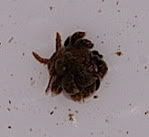
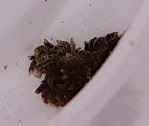
Control group

Each container contained two cups of water from the tank. Into one, there was added 4 drops of Salifert's FWE. Nothing was added into the control group in order to monitor the effects of the FWE versus nothing at all.
I had initially created a control group because I expected that this experiment would run its course during several hours, possibly days, and that it may or may not have worked. I had no idea how amazing the results would be, or how quickly they would happen.
In 30 seconds, one of the nudis in the test cup was falling from the side of the cup. In 45 seconds it looked like this.
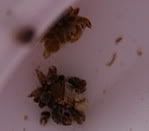
In 60 seconds
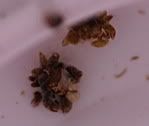
The results were fast, effective, and much, much less stressful for the zoanthids colonies than the freshwater iodine dip.
The control group showed no ill effects during this time. Obviously, the control group was not going to be "released into the wild," so I attempted to repeat the experiment by adding 4 drops of FWE since they were in better locations for pictures.
In 30 seconds stress sets in

In 45 seconds, lesions appear on the side of the nudi
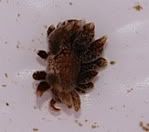
In 60 seconds the lesion spreads
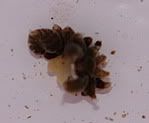
One of the nudis appendages falls off at 80 seconds

90 seconds it's falling to pieces
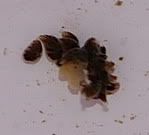
In a fantastically fast two mintues, all that is left of the nudibranch is what you see here. These results are nothing short of amazing.
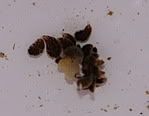
This treatment certainly seems to work wonders against zoanthid eating nudibranchs. In fact, Salifert's FWE proved to be completely safe for zoanthids colonies, it did not stress them at all! It is the only discovered treatment for zoanthids that not only has a 100% death rate for the nudibranch, but will also leave the zoanthids entirely unaffected.
Not only is FWE safe for your zoanthids, it is also reef safe! This means that if you have an infestation in your entire tank, you can now treat with a heavy dose of FWE and get all of the nudibranch, then retreat every week to deal with the newly hatched eggs for three weeks. Finally, a new treatment which is safe, very effective, and extremely easy for ridding your system of zoanthid eating nudibranch once and for all.
As always though, care is required, since 4 drops per 2-4 cups is nearly 4 times the recommended dosage, and is much easier (and much cheaper) to carry out in a bucket than in an entire system. Since this dipping system works with your regular tank water, you can leave the colonies in the bucket for nearly 30 minutes to several hours with no ill effects. They can then be placed into a bucket of only tank water for 10-30 minutes in order to remove any FWE that may still be on the colony, and placed back into the tank or quarantine system.
This method is also very much recommended for new colonies being introduced into your tank to avoid any further infestations. After being dipped in FWE, the colonies should be closely visually inspected for nudibranch eggs, which are not affected by FWE. The eggs are not difficult to find, they are approximately a 0.25in, thin strand of very bright white eggs. Remove them with a pair of tweezers, give the colony a good shake in the bucket water to clear any residue of the eggs, and then place the colony into your quarantine system. If you do not have a quarantine system then you may want to consider one to avoid any future infestations, otherwise the colony can be placed into your main system as long as it is very carefully monitored for a few days.
I hope that this pictorial has helped you as much as it has me, and that you can appreciate the beauty of your zoanthids without letting them ever become food again!
Taken From: http://www.practicalcoralfarming.com/zoonudis.html
Sundial Snail
Introduction to Sundial Snails: Heliacus variegatus is commonly known in the aquarium hobby as a Sundial snail or box snail. These nocturnal snails are known Zoanthid predators.
What a Sundial snail looks like: These snails are typical white and black, occasionally having an orange tint and a little protrusion on the back side, often referred to as a rattle snakes tail.
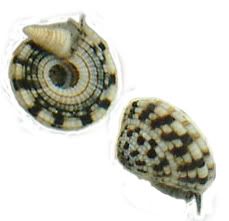
Signs of infestation: Viewing sundial snails in your aquarium. Additionally, one by one, your zoanthids will begin to slowly disappear.
Life Cycle of Sundial snails: Little is known about sundial snails' reproductive cycle other than they reproduce sexually making large infections rare.
Prevention: A quarantine tank is the easiest way to prevent these ugly little reef critters from destroying your Zoanthid based reef tank. Ideally Zoanthid corals should be left in quarantine for 3 months. During the quarantine time you should view the coral on a daily basis and watch for Sundial snails. Remember that Sundial snails like to stay hidden in the polyp mat and typical come out when the lights are off. Whether or not quarantine is an option, a dip in CoralRx is highly suggested.
Treatment: Treatment should be done in a quarantine tank. First step is to move the effected corals to a quarantine tank; the quarantine tank should have good light and water flow. Setup your quarantine tank, then take your coral out of the main tank and dip it in Coral Rx. While the coral is in CoralRx take a turkey baster, and blast the coral with the dip. Making sure it is getting in between the polyps and the underside of the coral. Do this for approximately 5 - 10 minutes. After 5 - 10 minutes, remove coral and discard the coral dip. Do not reuse the coral dip as parasites may release toxins. Rinse coral with clean saltwater and return to quarantine tank. Repeat every 4-8 days till no more snails are found. Leave the coral in your quarantine system for an additional 3 months before moving back to your aquarium.
Zoanthid Eating Spiders
Introduction to Zoanthid Eating Spiders:
Zoanthid Eating Spiders are marine arthropods of class Pycnogonida also called Pantopoda or Pycnogonid. There are over 1300 known species of Pycnogonida and it seems more than one type feed on Zoanthids. There may be other types of Pycnogonida that feed on other types of corals. This parasite does not run ramped in the marine hobby because they reproduce sexually, not asexually.
What Zoanthid Eating Spiders look like:
These sea spiders are typically eight legged, but may have other appendages that resemble legs. These appendages are used in caring for young and cleaning as well as courtship. The average size is about 5 mm across. The Zoanthid spider that we look for is very hard if not almost impossible to see as the spider crawls inside of the polyp as it closes. However, there are times when the spider's legs are exposed outside of the closed polyp, as shown in the picture below.
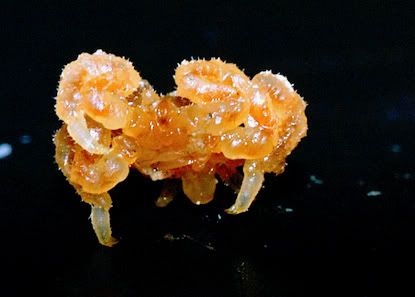
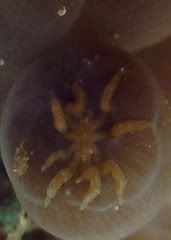


Life Cycle of Zoanthid Eating Spiders:
Sea spiders reproduce sexually, with the male caring the eggs. Sea spiders are not hermaphroditic, meaning they do not have both male and female reproductive organs. This is one of the reasons that we do not see them spread fast through the aquarium hobby.
Prevention of Zoanthid Eating Spiders: A quarantine tank is the easiest way to prevent these ugly little reef critters from destroying your Zoanthid based reef tank. Ideally Zoanthid corals should be left in quarantine for 3 months. During the quarantine time you should view the coral on a daily basis and look for spiders. Remember that Zoa Eating Spiders like to stay hidden in the polyp mat. Whether or not quarantine is an option, a dip in CoralRx is highly suggested.
Treatment of Zoanthid Eating Spiders: Treatment should be done in a quarantine tank. First step is to move the effected corals to a quarantine tank; the quarantine tank should have good light and water flow. Setup your quarantine tank, then take your coral out of the main tank and dip it in Coral Rx. While the coral is in CoralRx take a turkey baster, and blast the coral with the dip. Making sure it is getting in between the polyps and the underside of the coral. Do this for approximately 5 - 10 minutes. After 5 - 10 minutes, remove the coral and discard the coral dip. Do not reuse the coral dip as parasites may release toxins. Rinse coral with clean saltwater and return to quarantine tank. Repeat every 4-8 days till no more Spiders are found. Leave the coral in your quarantine system for an additional 3 months before moving back to your aquarium. Additionally, adding wrasses to your quarantine tank will also aid in treatment of Zoanthid Eating Spiders.
Irritators
Aiptasia
The infamous Aiptasia Anemone - notice the smaller ones sprouting up on the right side of this rock.
Aiptasia is a smaller anemone that can get to be about 1 inch (3 cm) in diameter, sometimes larger, and reproduces rapidly in a saltwater aquarium with abundant nutrients. They are sometimes called aptasia, glass anemone, tube anemone and rock anemone and there are several different species. This is one anemone that saltwater hobbyists don't purchase, rather this one comes in on the live rock as a hitchhiker.
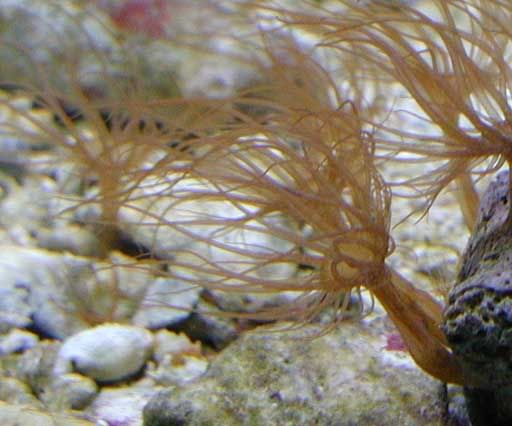
Picture of Aiptasia
It can be difficult to see them when they are small and you obviously wouldn't want to knowingly buy live rock if you saw this pest on it at the store. They can hide inside the small crevices and rock pores only to come out weeks or months later if they are given the right conditions.
Why are they considered a pest?
Well, they are not the most attractive looking specimen, they multiply rapidly and more importantly they can sting other, more desirable corals and other reef tank inhabitants. It's a typical story... You get some new rock and a few weeks go by and you notice a small anemone starting to grow on the rock. How neat, a free anemone! Well, the honeymoon ends a few weeks or months later when you notice that your live rock starts to become overgrown with them, especially if you have a reef tank with expensive corals!
Ways to Control Aiptasia
Controlling them can be a chore. If you try to smash them or cut them they are thought to release pieces of themselves into the water, thereby multiplying even more rapidly. Listed below are some natural and chemical methods for controlling aiptasia:
* First, if you can, reduce the amount of nutrients available to the anemone. This may mean limiting the amounts, types and frequency of fish and coral feedings. Do you just drop in a frozen fish food cube? Defrost the frozen food first and then slowly spoon feed it to the fish. Give the fish a little, give them 30 seconds to eat it all and then spoon feed them a little more. This makes for less waste and juices entering the tank and more food for the fish instead of the filter.
* Peppermint shrimp (Lysmata wurdemanni) are used by many hobbyists to eat this anemone. It can be hit or miss though. Especially if you get the wrong version of the "peppermint shrimp". There is another peppermint shrimp, Lysmata californica, that looks very similar to the wurdemanni but doesn't do the job on aiptasia that wurdemanni does.
* Raccoon Butterfly Fish and the Copperband Butterfly Fish will also eat this pest but they can pose other problems in reef tanks. They may eat and/or pick at corals. The copperband butterfly may be the better choice because it may be less inclined to eat or pick at corals than the Raccoon Butterfly but the Copperband is less hardy and more difficult to feed long-term. However, they may only eat bits and pieces of the aiptasia causing some the aiptasia to scatter and relocate in other places inside the tank.
* Bergia Nudibranch (Berghia verrucicornis) are great aptasia eaters but the problem with them is they might starve once the aiptasia is gone. They can also easily be eaten by tank mates.
* Calcium and Kalkwasser is thought to destroy aiptasia too. The trick is applying it directly into the anemone or on the oral disk using a syringe before it retreats into its hole.
* A sting from an Elegance Coral (Catalaphyllia jardinei) is supposed to kill them. If you have one and you can pick up your elegance coral by the base, this may be an option for you.
Foraminiferan
Foraminiferan (Note: this is currently classified as an Irritator. However it is currently up for debate if it is an actual Predator! It is recommended to not take chances and pull them out of your system if you have them at this time.) A discussion on the topic is available here: http://reefcentral.com/forums/showthread.php?s=&threadid=966131
Hydroids
Hydroids come in many shapes and sizes. If you have something that sorta resembles a feather duster, but not really... look into hydroids. They can pack a mighty sting so it is good not to let them grow next to corals. They can be brown like these, white, pink, or other colors.
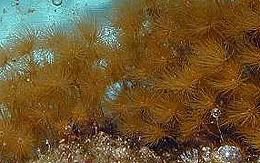
Spaghetti Worm
You may have some odd hairs squirming about on your sandbed. They may be red, green, brown, or white. They grab food too. Looks like you have hair worms (commonly called spaghetti worms).

Spionid Worm
These worms also live in tubes, but rather than filter feeding like the dusters, they will grab larger food with their palps (the antenna-looking things). They are good scavengers.
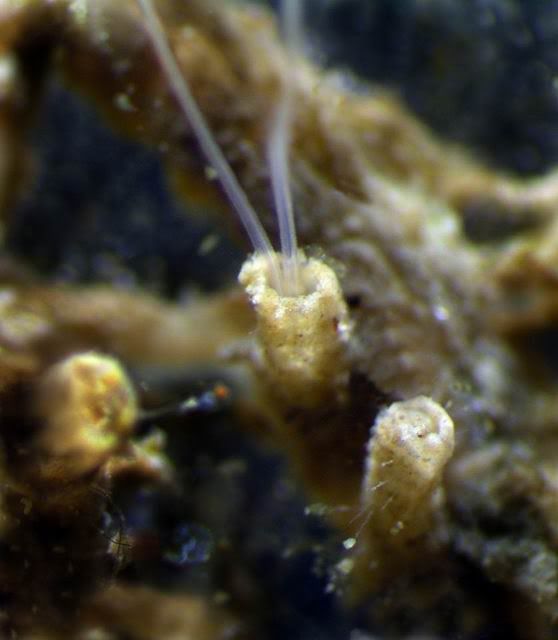
Vermetid Snail
The vermitid snail is yet another critter that lives in a tube. These filter feed by throwing out a mucous "net" to catch food. Most of the time, you won't see the worm but will be wondering what the "spiderwebs" in your tank are. Here's your culprit. They are harmless but can irritate corals if their nets are too close.
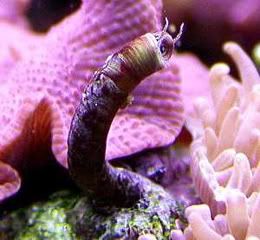
Amphipod
Here is an excellent closeup picture of what appears to be an Amphipod. Some Aquarists claim they have seen them eating healthy zoa polyps, but that has yet to be proven. Normally, they only cause the polyps to close.

Majano Anemone
Majano anemones, found in the middle of a zoanthid colony, was causing polyps to close and created a bare spot. After eradication, everything returned to normal.

Disease
Fungus
Whether or not it truly is a fungus is unclear, but certain Zoanthids, particularly pink Palythoa can get a fungus-like infection. One treatment that works well is to dip the infected colony in a solution of 80% tank water, 20% Hydrogen Peroxide for UP TO 5 minutes. This dip is strong and irritates the colony along with killing the infection, so do not dip the colony too long.
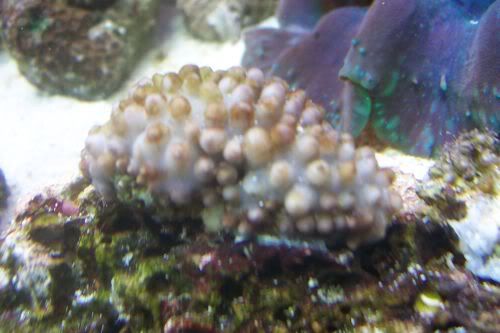
Zoa Pox
Detailed Information Click Here
Predators
Asterina Starfish!!
Not all Asterina Starfish are Zoanthid predators. In fact, as a whole, Asterinas are generally considered Reef Safe. However, the Asterina family is HUGE and there are types that do eat/kill Zoanthids!
Nudibranch or Nudis!!
One of the most difficult pests to fully eradicate in most reef systems are the Zoanthid eating nudibranch. With their uncanny ability to hitchhike into the tank in nearly any coral colony, and to spread into plague proportions at record speed, they have fully established their reputation as a pest that cannot be taken lightly. Over the years, several methods for treating these pests have emerged, from freshwater iodine dips to manual removal, but all of these methods seemed to extremely stress the zoanthid colonies as well. Zoanthids were being lost during dips, they became much more susceptible to fungus, and a new method had yet to emerge.
I had initially set out to remove another pest: a large mass of flatworms that were on a colony of zoanthids. The red flatworms had reproduced to the point that they were completely drowning out the zoanthids, and the colony had been closed for nearly a week. I placed 8 drops of Salifert's Flatworm Exit (FWE), an excellent flatworm treatment medication, into 3 gallons of tank water in a bucket.
After 10 minutes, I removed the zoanthids colony, and noted that all of the flatworms were dead at the bottom of the bucket. Much more interestingly, however, I noticed that there were a few zoanthids eating nudibranchs that were also at the bottom of the bucket, whether alive or dead it was hard to tell, but they had certainly been removed from the colony. Immediately curious, I collected some nudibranch from a colony of zoanthids that was still acclimating and waiting to be dipped in iodine and freshwater for nudibranch removal.
The nudis were placed into two containers, one containing a test group and one a control group.
Test group


Control group

Each container contained two cups of water from the tank. Into one, there was added 4 drops of Salifert's FWE. Nothing was added into the control group in order to monitor the effects of the FWE versus nothing at all.
I had initially created a control group because I expected that this experiment would run its course during several hours, possibly days, and that it may or may not have worked. I had no idea how amazing the results would be, or how quickly they would happen.
In 30 seconds, one of the nudis in the test cup was falling from the side of the cup. In 45 seconds it looked like this.

In 60 seconds

The results were fast, effective, and much, much less stressful for the zoanthids colonies than the freshwater iodine dip.
The control group showed no ill effects during this time. Obviously, the control group was not going to be "released into the wild," so I attempted to repeat the experiment by adding 4 drops of FWE since they were in better locations for pictures.
In 30 seconds stress sets in

In 45 seconds, lesions appear on the side of the nudi

In 60 seconds the lesion spreads

One of the nudis appendages falls off at 80 seconds

90 seconds it's falling to pieces

In a fantastically fast two mintues, all that is left of the nudibranch is what you see here. These results are nothing short of amazing.

This treatment certainly seems to work wonders against zoanthid eating nudibranchs. In fact, Salifert's FWE proved to be completely safe for zoanthids colonies, it did not stress them at all! It is the only discovered treatment for zoanthids that not only has a 100% death rate for the nudibranch, but will also leave the zoanthids entirely unaffected.
Not only is FWE safe for your zoanthids, it is also reef safe! This means that if you have an infestation in your entire tank, you can now treat with a heavy dose of FWE and get all of the nudibranch, then retreat every week to deal with the newly hatched eggs for three weeks. Finally, a new treatment which is safe, very effective, and extremely easy for ridding your system of zoanthid eating nudibranch once and for all.
As always though, care is required, since 4 drops per 2-4 cups is nearly 4 times the recommended dosage, and is much easier (and much cheaper) to carry out in a bucket than in an entire system. Since this dipping system works with your regular tank water, you can leave the colonies in the bucket for nearly 30 minutes to several hours with no ill effects. They can then be placed into a bucket of only tank water for 10-30 minutes in order to remove any FWE that may still be on the colony, and placed back into the tank or quarantine system.
This method is also very much recommended for new colonies being introduced into your tank to avoid any further infestations. After being dipped in FWE, the colonies should be closely visually inspected for nudibranch eggs, which are not affected by FWE. The eggs are not difficult to find, they are approximately a 0.25in, thin strand of very bright white eggs. Remove them with a pair of tweezers, give the colony a good shake in the bucket water to clear any residue of the eggs, and then place the colony into your quarantine system. If you do not have a quarantine system then you may want to consider one to avoid any future infestations, otherwise the colony can be placed into your main system as long as it is very carefully monitored for a few days.
I hope that this pictorial has helped you as much as it has me, and that you can appreciate the beauty of your zoanthids without letting them ever become food again!
Taken From: http://www.practicalcoralfarming.com/zoonudis.html
Sundial Snail
Introduction to Sundial Snails: Heliacus variegatus is commonly known in the aquarium hobby as a Sundial snail or box snail. These nocturnal snails are known Zoanthid predators.
What a Sundial snail looks like: These snails are typical white and black, occasionally having an orange tint and a little protrusion on the back side, often referred to as a rattle snakes tail.

Signs of infestation: Viewing sundial snails in your aquarium. Additionally, one by one, your zoanthids will begin to slowly disappear.
Life Cycle of Sundial snails: Little is known about sundial snails' reproductive cycle other than they reproduce sexually making large infections rare.
Prevention: A quarantine tank is the easiest way to prevent these ugly little reef critters from destroying your Zoanthid based reef tank. Ideally Zoanthid corals should be left in quarantine for 3 months. During the quarantine time you should view the coral on a daily basis and watch for Sundial snails. Remember that Sundial snails like to stay hidden in the polyp mat and typical come out when the lights are off. Whether or not quarantine is an option, a dip in CoralRx is highly suggested.
Treatment: Treatment should be done in a quarantine tank. First step is to move the effected corals to a quarantine tank; the quarantine tank should have good light and water flow. Setup your quarantine tank, then take your coral out of the main tank and dip it in Coral Rx. While the coral is in CoralRx take a turkey baster, and blast the coral with the dip. Making sure it is getting in between the polyps and the underside of the coral. Do this for approximately 5 - 10 minutes. After 5 - 10 minutes, remove coral and discard the coral dip. Do not reuse the coral dip as parasites may release toxins. Rinse coral with clean saltwater and return to quarantine tank. Repeat every 4-8 days till no more snails are found. Leave the coral in your quarantine system for an additional 3 months before moving back to your aquarium.
Zoanthid Eating Spiders
Introduction to Zoanthid Eating Spiders:
Zoanthid Eating Spiders are marine arthropods of class Pycnogonida also called Pantopoda or Pycnogonid. There are over 1300 known species of Pycnogonida and it seems more than one type feed on Zoanthids. There may be other types of Pycnogonida that feed on other types of corals. This parasite does not run ramped in the marine hobby because they reproduce sexually, not asexually.
What Zoanthid Eating Spiders look like:
These sea spiders are typically eight legged, but may have other appendages that resemble legs. These appendages are used in caring for young and cleaning as well as courtship. The average size is about 5 mm across. The Zoanthid spider that we look for is very hard if not almost impossible to see as the spider crawls inside of the polyp as it closes. However, there are times when the spider's legs are exposed outside of the closed polyp, as shown in the picture below.




Life Cycle of Zoanthid Eating Spiders:
Sea spiders reproduce sexually, with the male caring the eggs. Sea spiders are not hermaphroditic, meaning they do not have both male and female reproductive organs. This is one of the reasons that we do not see them spread fast through the aquarium hobby.
Prevention of Zoanthid Eating Spiders: A quarantine tank is the easiest way to prevent these ugly little reef critters from destroying your Zoanthid based reef tank. Ideally Zoanthid corals should be left in quarantine for 3 months. During the quarantine time you should view the coral on a daily basis and look for spiders. Remember that Zoa Eating Spiders like to stay hidden in the polyp mat. Whether or not quarantine is an option, a dip in CoralRx is highly suggested.
Treatment of Zoanthid Eating Spiders: Treatment should be done in a quarantine tank. First step is to move the effected corals to a quarantine tank; the quarantine tank should have good light and water flow. Setup your quarantine tank, then take your coral out of the main tank and dip it in Coral Rx. While the coral is in CoralRx take a turkey baster, and blast the coral with the dip. Making sure it is getting in between the polyps and the underside of the coral. Do this for approximately 5 - 10 minutes. After 5 - 10 minutes, remove the coral and discard the coral dip. Do not reuse the coral dip as parasites may release toxins. Rinse coral with clean saltwater and return to quarantine tank. Repeat every 4-8 days till no more Spiders are found. Leave the coral in your quarantine system for an additional 3 months before moving back to your aquarium. Additionally, adding wrasses to your quarantine tank will also aid in treatment of Zoanthid Eating Spiders.
Irritators
Aiptasia
The infamous Aiptasia Anemone - notice the smaller ones sprouting up on the right side of this rock.
Aiptasia is a smaller anemone that can get to be about 1 inch (3 cm) in diameter, sometimes larger, and reproduces rapidly in a saltwater aquarium with abundant nutrients. They are sometimes called aptasia, glass anemone, tube anemone and rock anemone and there are several different species. This is one anemone that saltwater hobbyists don't purchase, rather this one comes in on the live rock as a hitchhiker.

Picture of Aiptasia
It can be difficult to see them when they are small and you obviously wouldn't want to knowingly buy live rock if you saw this pest on it at the store. They can hide inside the small crevices and rock pores only to come out weeks or months later if they are given the right conditions.
Why are they considered a pest?
Well, they are not the most attractive looking specimen, they multiply rapidly and more importantly they can sting other, more desirable corals and other reef tank inhabitants. It's a typical story... You get some new rock and a few weeks go by and you notice a small anemone starting to grow on the rock. How neat, a free anemone! Well, the honeymoon ends a few weeks or months later when you notice that your live rock starts to become overgrown with them, especially if you have a reef tank with expensive corals!
Ways to Control Aiptasia
Controlling them can be a chore. If you try to smash them or cut them they are thought to release pieces of themselves into the water, thereby multiplying even more rapidly. Listed below are some natural and chemical methods for controlling aiptasia:
* First, if you can, reduce the amount of nutrients available to the anemone. This may mean limiting the amounts, types and frequency of fish and coral feedings. Do you just drop in a frozen fish food cube? Defrost the frozen food first and then slowly spoon feed it to the fish. Give the fish a little, give them 30 seconds to eat it all and then spoon feed them a little more. This makes for less waste and juices entering the tank and more food for the fish instead of the filter.
* Peppermint shrimp (Lysmata wurdemanni) are used by many hobbyists to eat this anemone. It can be hit or miss though. Especially if you get the wrong version of the "peppermint shrimp". There is another peppermint shrimp, Lysmata californica, that looks very similar to the wurdemanni but doesn't do the job on aiptasia that wurdemanni does.
* Raccoon Butterfly Fish and the Copperband Butterfly Fish will also eat this pest but they can pose other problems in reef tanks. They may eat and/or pick at corals. The copperband butterfly may be the better choice because it may be less inclined to eat or pick at corals than the Raccoon Butterfly but the Copperband is less hardy and more difficult to feed long-term. However, they may only eat bits and pieces of the aiptasia causing some the aiptasia to scatter and relocate in other places inside the tank.
* Bergia Nudibranch (Berghia verrucicornis) are great aptasia eaters but the problem with them is they might starve once the aiptasia is gone. They can also easily be eaten by tank mates.
* Calcium and Kalkwasser is thought to destroy aiptasia too. The trick is applying it directly into the anemone or on the oral disk using a syringe before it retreats into its hole.
* A sting from an Elegance Coral (Catalaphyllia jardinei) is supposed to kill them. If you have one and you can pick up your elegance coral by the base, this may be an option for you.
Foraminiferan
Foraminiferan (Note: this is currently classified as an Irritator. However it is currently up for debate if it is an actual Predator! It is recommended to not take chances and pull them out of your system if you have them at this time.) A discussion on the topic is available here: http://reefcentral.com/forums/showthread.php?s=&threadid=966131
Hydroids
Hydroids come in many shapes and sizes. If you have something that sorta resembles a feather duster, but not really... look into hydroids. They can pack a mighty sting so it is good not to let them grow next to corals. They can be brown like these, white, pink, or other colors.

Spaghetti Worm
You may have some odd hairs squirming about on your sandbed. They may be red, green, brown, or white. They grab food too. Looks like you have hair worms (commonly called spaghetti worms).

Spionid Worm
These worms also live in tubes, but rather than filter feeding like the dusters, they will grab larger food with their palps (the antenna-looking things). They are good scavengers.

Vermetid Snail
The vermitid snail is yet another critter that lives in a tube. These filter feed by throwing out a mucous "net" to catch food. Most of the time, you won't see the worm but will be wondering what the "spiderwebs" in your tank are. Here's your culprit. They are harmless but can irritate corals if their nets are too close.

Amphipod
Here is an excellent closeup picture of what appears to be an Amphipod. Some Aquarists claim they have seen them eating healthy zoa polyps, but that has yet to be proven. Normally, they only cause the polyps to close.

Majano Anemone
Majano anemones, found in the middle of a zoanthid colony, was causing polyps to close and created a bare spot. After eradication, everything returned to normal.

Disease
Fungus
Whether or not it truly is a fungus is unclear, but certain Zoanthids, particularly pink Palythoa can get a fungus-like infection. One treatment that works well is to dip the infected colony in a solution of 80% tank water, 20% Hydrogen Peroxide for UP TO 5 minutes. This dip is strong and irritates the colony along with killing the infection, so do not dip the colony too long.

Zoa Pox
Detailed Information Click Here